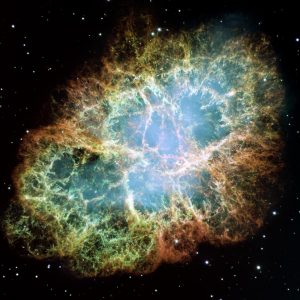Messier 1 — The Crab Nebula: a supernova’s heartbeat you can still see
In July 1054, a star blew up so brightly people saw it in daylight. Its “afterglow” is Messier 1—the Crab Nebula—powered by a neutron-star lighthouse pulsing ~30 times a second. Here’s the story, how to find it from North Texas, and how to capture it.
What is M1?
Messier 1—the Crab Nebula—is the expanding debris of a star that exploded in 1054 CE, recorded across East Asia and the Middle East. At its center spins a neutron star (the Crab Pulsar), sweeping beams like a cosmic lighthouse about 30 times per second—that engine powers the nebula’s glow. Distance: ~6,500 light-years in Taurus. Apparent size: ~7′×5′, visual magnitude ~8.4.
Why it’s awesome
This is a time machine you can aim a backyard scope at—shock fronts, tangled filaments, and synchrotron glow from particles whipped to near-light-speed by the pulsar’s magnetic fields. The debris is still expanding ~1,000–2,000 km/s (non-uniformly!), so every deep image is a tiny frame in a 1,000-year slow-motion movie.
How to find it (Denton/Argyle & mid-north latitudes)
Season: Best November–February. In winter it climbs high—peaks ~79° up from North Texas (Dec +22° vs. lat ~33°). Star-hop: Start at Zeta Tauri (the eastern horn tip of Taurus). M1 sits about 1.1–1.2° northwest of Zeta Tauri—barely more than a pinky-width at arm’s length. Timing: By December, it’s well up by mid-evening and nearly overhead after midnight; in January, it’s prime by 9–10 p.m.
What to use & what to expect
Naked eye: Too faint.
Binoculars (50–70 mm): Under dark skies you’ll tease out a small, oval haze.
Telescopes (4–8″+): The oval brightens; with UHC/O-III filters you’ll coax more contrast in the filaments. Under Bortle 5–6, give your eyes 20–30 min to dark-adapt and use averted vision.
Imaging: Short, many sub-exposures (e.g., 10–30 s) add up beautifully; narrowband (H-alpha/SII/O-III) reveals structure, RGB brings the blue synchrotron glow.
Vespera 2 note: Search “M1 (Crab Nebula)” in Singularity. Manual coordinates if needed: RA 05h 34m 31s, Dec +22° 00′ 52″.
Quick facts
Type: Supernova remnant + pulsar wind nebula Constellation: Taurus Distance: ~6,500 ly Core: Crab Pulsar (PSR B0531+21), ~33 ms rotation period Also known as: NGC 1952, Taurus A, Sh2-244
Verified Visuals (public, no-login)
JWST (NIRCam + MIRI): official image + explainer (NASA) and science page (WebbTelescope). Hubble: iconic mosaic + multi-wavelength resources. Chandra X-ray: composite showing the pulsar wind. Finder/Charts: TheSkyLive target page for M1.
Pronunciation: Messier (“meh-see-AY”), Taurus (“TAWR-uss”), Zeta Tauri (“ZAY-tuh TOWER-eye”).
Share this content:


